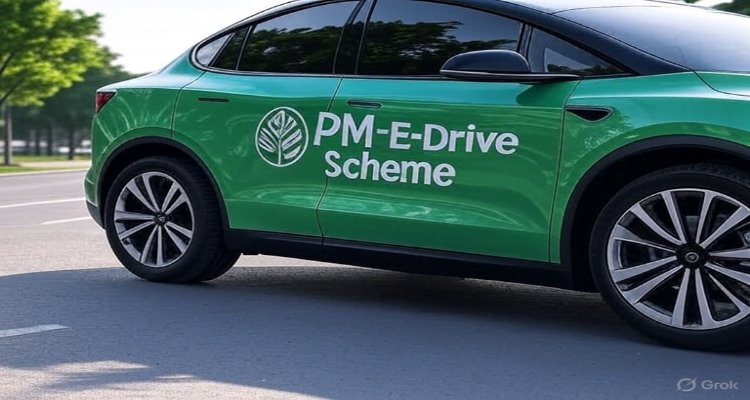PM E-Drive Scheme

India launches the ₹10,900 crore PM E-Drive scheme to accelerate EV adoption, expand charging infrastructure, and boost green mobility.
A Bold Step Towards Green Mobility
India has taken a decisive leap in its electric mobility journey with the launch of the PM Electric Drive Revolution in Innovative Vehicle Enhancement (PM E-DRIVE) Scheme. Announced on September 29, 2024, the ₹10,900 crore initiative aims to transform the way the country moves—prioritizing cleaner transport, stronger EV infrastructure, and greener public transit solutions.
At its heart, the scheme is designed to make electric mobility affordable, accessible, and sustainable—especially for public transport users and commercial operators who power India’s fast-growing cities.
Context and Background
India’s push for electric vehicles (EVs) has been gaining momentum over the last decade, with several incentive-based programs encouraging adoption. Most recently, the Electric Mobility Promotion Scheme (EMPS) 2024, which ran for six months from April to September 2024, offered targeted subsidies to expand EV uptake.
Now, EMPS has been subsumed into the PM E-DRIVE scheme, signaling a broader, more ambitious roadmap. The new framework not only emphasizes vehicle adoption but also focuses on the ecosystem around EVs—from charging infrastructure and manufacturing to testing and standardization.
With transport contributing nearly 13% of India’s carbon emissions, policymakers view electrification as central to achieving net-zero commitments and improving urban air quality.
Main Developments Under PM E-Drive
The PM E-Drive scheme is structured into clear components with measurable targets:
1. Public EV Charging Infrastructure
- Budget: ₹2,000 crore earmarked for charging station deployment.
- Implementing Agency: Bharat Heavy Electricals Limited (BHEL) will oversee installation nationwide.
- Focus Areas:
- Cities with over one million population
- Smart cities and metro-linked towns
- State capitals
- High-density highways
- Public transport hubs such as railway stations, airports, and fuel retail outlets
Government premises—including offices, hospitals, and educational institutions—will receive 100% subsidy on infrastructure, provided chargers remain open for public access.
2. Demand Incentives
- Allocation: ₹3,679 crore for subsidizing e-2W, e-3W, e-ambulances, e-trucks, and emerging EV categories.
- Focuses on making EVs cost-competitive for commercial operators and public service providers.
3. Capital Asset Creation
- Allocation: ₹7,171 crore to support:
- Procurement of e-buses
- Establishment of charging networks
- Upgradation of EV testing and certification agencies
4. Administration and Outreach
- Includes Information, Education & Communication (IEC) activities to raise awareness and ensure smooth project management.
Expert Insight and Public Sentiment
Policy experts view the scheme as a “next-generation mobility push”. According to a Delhi-based energy analyst, “PM E-Drive is not just about EVs—it’s about creating an ecosystem where charging is as easy as refueling. That’s the real game-changer.”
Public reaction has also been cautiously optimistic. EV manufacturers expect demand to rise with extended subsidies, while city planners see relief in addressing urban pollution and traffic congestion. However, concerns remain about execution speed, grid readiness, and affordability for smaller operators.
Impact and Implications
The scheme has far-reaching implications:
- For Commuters: More affordable EV-based public transport and wider access to charging points.
- For Businesses: Lower operational costs for commercial fleets and incentives for EV adoption in logistics and delivery sectors.
- For Environment: Reduced dependency on fossil fuels, improved urban air quality, and contribution to India’s net-zero goals.
- For Industry: Boost to domestic EV manufacturing, creating new jobs and advancing India’s role in the global green economy.
If implemented effectively, PM E-Drive could place India among the global frontrunners in electric mobility, alongside China and Europe.
Conclusion
The PM E-Drive scheme is more than a government subsidy—it’s a national vision for clean, affordable, and futuristic mobility. With a two-year ₹10,900 crore outlay, it brings together infrastructure, incentives, and industry support under one umbrella.
Success, however, will hinge on rapid implementation, collaboration with private players, and ensuring that benefits reach everyday commuters. If these challenges are met, PM E-Drive could be the catalyst that shifts India’s mobility narrative towards sustainability and resilience.
Disclaimer: This article is for informational purposes only. It does not represent official government communication and should not be considered as financial or policy advice.










